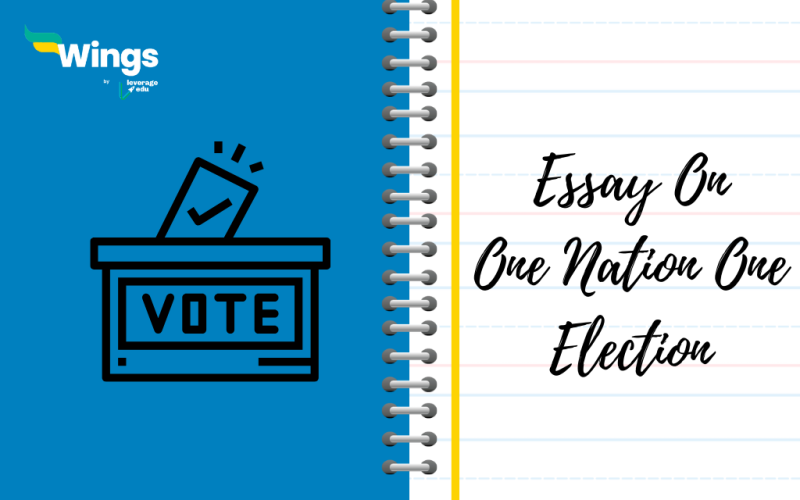One Nation One Election Essay: The main idea of the “One Nation One Election (ONOE)” is to have all Vidhan Sabha or state elections happen at the same time as the Lok Sabha or general elections every five years. This concept aims to make the electoral process more efficient by reducing the number of elections and saving time and resources.
In India, the concept of ONOE has been around since 1983. It was proposed by the then Election Commission of India (ECI). However, before 1967, India regularly conducted simultaneous elections. The first time general elections and state legislative assembly elections were held together was in 1951-52. This practice continued in 1957, 1962, and 1967.
Unfortunately, due to the early dissolution of some Legislative Assemblies in 1968 and 1969, the cycle was disrupted. In 1970, the Lok Sabha itself was dissolved prematurely, leading to fresh elections in 1971. So, until 1970, only the First, Second, and Third Lok Sabha completed full five-year terms.
Also Read: Essay on Bhimrao Ambedkar in 500 Words
Resurfacing of One Nation One Election
After many decades, the idea of “One Nation One Election” resurfaced again in 2023. In September 2023, the Union Government of India established a ‘High-Level Committee on ONOE’. The committee was chaired by former President of India Ramnath Kovind.
Since then, the committee has convened three times and gathered opinions from political parties and eminent jurists. While there is no set timeline for the committee’s recommendations, the fact that it aligns with the lead-up to the 2024 general elections raises concerns. Given the potential to reshape the democratic structure and federal system, it is crucial to promptly analyze the legal aspects of this initiative.
Also Read: Essay on Democracy in 100, 300 and 500 Words
Countries following One Nation One Election
Many countries like Sweden and South America follow the One Nation One Election policy. In Sweden, elections are conducted according to a fixed schedule. The elections for the provincial legislature (Landsting), local bodies (Kommunfullmaktige), and national legislature (Riksdag) are conducted every fourth year on a set date, specifically on the second Sunday in September.
Furthermore, in South Africa, elections for both the national and provincial legislatures take place simultaneously every five years. However, Municipal elections are held separately, occurring two years after the national and provincial elections.
Also Read: How is the Speaker of Lok Sabha Elected?
Advantages of One Nation One Election
The main advantage of ‘One Nation, One Election’ is the reduction in election costs, as each separate election requires a significant amount of financial resources. Also, simultaneous elections would allow the government to focus more on governance rather than being in election mode. With a reduced focus on elections all around the country, political parties in power can prioritize development over election campaigns.
Additionally, holding simultaneous elections would reduce the workload on administrative and security forces. Besides, ONOE will boost voter turnout because it will be easier for people to cast multiple ballots at once.
Also Read: What is Representative Democracy?
Disadvantages of One Nation One Election
On the other hand, critics of unified elections in India believe that the cost of conducting free and fair elections to choose a government elected by the people is a price that should never be considered too high. They propound that having elections simultaneously undermines the autonomy and independence of state governments. This not only weakens the federal structure but also raises the potential for conflicts of interest between the central government and the states.
Also, implementing simultaneous elections presents big challenges, like making sure there are enough secure electronic voting machines, personnel, and other necessary resources.
Thus, we can conclude that despite being cost-effective and convenient, one nation one election is dangerous to a democratic country like India as it is a threat to the autonomy of the state governments. Besides, simultaneous elections would obstruct the growth of regional parties as as the spotlight on national issues during a unified electoral process may overshadow regional concerns.
Also Read: Essay on Indian Constitution in 100, 250, and 350 words
FAQs
Ans: The then-President of India, Mr Ramnath Kovind, chaired the committee.
Ans: You can start by defining ONOE. Following this, you can mention the advantages and disadvantages of simultaneous elections. Also, you can explain its significance in the Indian context and other countries that conduct unified elections.
Ans: Sweden, South Africa, and Britain conduct simultaneous elections.
You can also explore:
Follow Leverage Edu for more interesting topics on school education and essay writing.
 One app for all your study abroad needs
One app for all your study abroad needs













